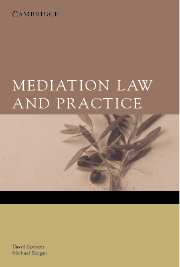Book contents
- Frontmatter
- Contents
- Acknowledgements
- Preface
- List of tables and figures
- Table of statutes
- Table of cases
- PART I THE PRACTICE OF MEDIATION
- 1 Mediation: Its Definition and History
- 2 The Mediation Process
- 3 The Theory and Philosophy of Mediation
- 4 Specific Types of Mediation
- 5 The Mediator
- 6 The Ethics of Mediation
- 7 Power, Empowerment and Difference in Mediation
- PART II THE LAW OF MEDIATION
- Bibliography
- Index
2 - The Mediation Process
Published online by Cambridge University Press: 05 June 2012
- Frontmatter
- Contents
- Acknowledgements
- Preface
- List of tables and figures
- Table of statutes
- Table of cases
- PART I THE PRACTICE OF MEDIATION
- 1 Mediation: Its Definition and History
- 2 The Mediation Process
- 3 The Theory and Philosophy of Mediation
- 4 Specific Types of Mediation
- 5 The Mediator
- 6 The Ethics of Mediation
- 7 Power, Empowerment and Difference in Mediation
- PART II THE LAW OF MEDIATION
- Bibliography
- Index
Summary
Introduction
As discussed in Chapter 1, mediation is the specialised form, activity or process by which the parties are assisted in their negotiations by a neutral third party, the mediator. The key point is that mediation is a negotiation between two or more parties in conflict, aided by a third party. Fundamental to mediation – or perhaps better described as a subset of it – is negotiation itself. A mediation cannot exist without negotiation. However, when we discuss ‘how to mediate’ we are focusing on the component parts of the process known as mediation. In this chapter the aim is to provide you with an overview of the classical model of mediation and the practical steps within that model. One modified approach to the classical model, co-mediation, will also be explained. (How mediation operates in different fields is the subject of Chapter 4.) In addition, this chapter will provide guidance on how to prepare for a mediation, make detailed reference to intake procedures and conclude with checklists designed to assist any mediator in their preparation for and conduct of mediations.
Intake procedures
In addition to personal preparations, many mediators engage in an ‘intake procedure’ prior to a mediation. Having an intake procedure when first engaging with clients to a mediation is a form of preparation that deserves its own consideration. This is designed to ensure that the parties are ready to mediate. Some commentators question whether there is a necessity for a pre-mediation intake process or conference (Lancken 2000).
- Type
- Chapter
- Information
- Mediation Law and Practice , pp. 42 - 82Publisher: Cambridge University PressPrint publication year: 2007



